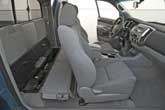Recent Articles
Popular Makes
Body Types
2005 Toyota Tacoma
Car people turning into truck people
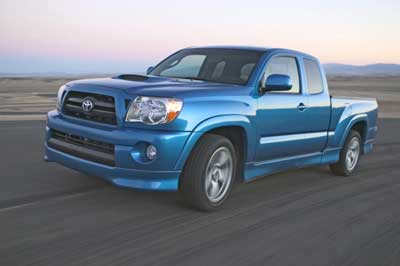
ANCHORAGE, AK-There are Car People. And, there are Truck People, and never should the two come to an agreement when it comes to the things that make vehicles worth talking about. It's a divide between those who appreciate the ride and those who want to take that ride down a ditch - with some cargo in back.Consider the divide conquered. After a day spent behind the wheel of the all-new Toyota Tacoma, it's clear that the traditional choice between car comfort and pickup practicality is really no longer a choice at all: The eighth-generation of Toyota's original compact pickup delivers both, and may well be the easiest pickup to live with in recent memory.
Page 2: Winner
Though by name the Tacoma was first sold in 1995 with the introduction of a made-in-America model, Toyota actually started selling pickups in the US in 1964. Since then, they have won numerous awards from the automotive press and have developed a loyal following among consumers. But with a host of new or newly remade competitors-including the Chevy Colorado/GMC Canyon twins, Dodge Dakota, and Nissan Frontier-Toyota knew it had to reinvent the Tacoma by adding size and power while at the same time, somehow increasing maneuverability, fuel economy and improving ride comfort and handling. It was an ambitious undertaking, to be sure. Based on a day-long drive along the winding roads and rutted trails on the outskirts of Alaska's largest city, Toyota has managed to pull it off.
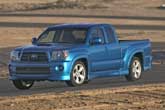
Page 3: Big & Strong
Like just about everything else in our bigger-is-better world, the new Tacoma has grown in both size and capability. The once-compact Tacoma is now nearly six inches longer, two-inches taller and, most significantly, nearly four inches wider than the outgoing model. The result is a midsize pickup truck with substantially more room for passengers and cargo. The Tacoma also now shares the same underpinnings as the automaker's midsize Toyota 4Runner and Lexus GX470 sport-utility vehicles. According to Toyota, it's this stronger chassis that gives the 2005 Toyota Tacoma improved ride and handling characteristics. Toyota engineers also managed to work in a complete overhaul of the Tacoma's powertrain, adding a new 2.7-liter inline four-cylinder engine and a larger and significantly more robust 4.0-liter V-6 and two new transmissions. These beefed-up mechanicals boost Tacoma's maximum towing capacity by 1500 pounds.
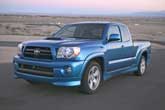
Page 4: Lots of Choices
Toyota is building the Tacoma in four distinct body styles, including a two-door Regular Cab and an extended Access Cab with rear jump seats and four clamshell-style doors. The four-door Double Cab also returns for 2005, this time with a choice between the familiar short bed or a new long bed.In addition to these basic body styles, the 2005 Tacoma lineup features two models: The first, dubbed the PreRunner after the trucks off-road racers use to scout (or "pre-run") the race course, offers the rugged looks and suspension bits of four-wheel drive models in a less expensive two-wheel drive package. The second, a new limited-production two-wheel drive model dubbed the X-Runner because of its X-shaped cross brace-reinforced frame, combines the looks and performance of a sports compact car with the active lifestyle benefits of a pickup. Add it all up and there are a total of 18 different Tacoma models. While choosing from such a mind-boggling array of possibilities may seem off-putting at first, the upside is that almost everyone should be able to find a Tacoma that matches their needs.
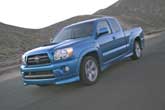
Page 5: A New Look
Changes to the 2005 Tacoma exterior are subtle, designed to bring its looks more in line with other members of the Toyota truck family. The biggest changes include more prominent headlights, bolder crossbars in the front grille, and upswept creases on the front and rear fenders. The PreRunner and four-wheel drive models also get larger wheel flares to both enhance their muscular appearance while deflecting mud and other trail debris in off-road excursions. These new styling cues give the Tacoma an odd cartoonish look, but the package achieves the rugged appearance its designers sought to achieve.The Tacoma's interior is an ideal blend of form and function. The design is pleasing to the eye, while important controls are exactly where you'd expect them to be and work with simple, intuitive operation. Though the cabin is attractively styled, some of the hard plastics should be replaced with softer-touch materials. The Tacoma's larger dimensions have created a more spacious cabin with abundant head, shoulder, and legroom. Taller drivers and passengers will find the front seats on Access and Double Cab models more accommodating thanks to the front seats' additional fore-aft travel. On Double Cab models with standard bucket seats, the front passenger seat folds flat to double as a workspace or table. Larger rear doors on Access Cab and Double Cab models that open to nearly 90 degrees make for easy entry and exit. Like most extended cab pickups, the two rear jump seats in Access Cab models are cramped enough that they're really only useful in a pinch. The rear bench seat in the Double Cab version is another story, having been raised by 1.25 inches and given a 23-degree seatback angle for greater comfort.

Page 6: Golden Silence
To go along with greater comfort, Toyota has managed to make the cab of the Tacoma a quieter place to be. Toyota engineers devoted a significant amount of attention to achieving this goal. Among the changes are aerodynamic improvements designed to help reduce wind noise and additional sound dampening materials in the headliner, on the floor, and behind the rear seats. While the result isn't exactly a luxury sedan hush, it's quiet enough to hear details in a favorite song, which is an improvement over some of Tacoma's competitors.Bed Length For bigger loads, the Tacoma offers a choice of two bed lengths. Regular and Access Cab models come standard with the 73.5-inch long bed. For the first time Double Cab models will be offered with a choice of a 60.3 inch short bed or the same 73.5-inch long bed. We think this last option-which means crew cab buyers will no longer have to give up cargo room to gain the additional passenger space as is the case with other four-door pickups that are only offered with short beds-gives the Tacoma a distinct advantage over the competition.
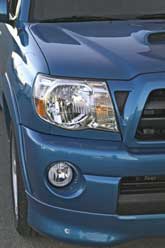
Page 7: Your Inner Bed
Also new is Toyota's use of a composite inner bed which weighs 10 percent less and yet is tougher and more corrosion- and dent-resistant than steel. Built into the bed are grooves that allow owners to create a two-tier inner deck plus four adjustable tie-down cleats. A full range of bed accessories including bike mounts, cargo crossbars, diamond-plate tool boxes, and a 400-watt, 115-volt AC power point add still more flexibility. For buyers looking to maximize cargo capacity, Double Cab models also offer an optional roof rack system.Larger bed sizes should make the truck folks happy. But Toyota hasn't forgotten the car types out there, those who want more room and versatility inside the cab. To that end, Access and Double Cab models feature rear seats that flip forward and fold flat, as well as underseat storage bins. Double Cab models include storage compartments behind the rear seat. Elsewhere in the interior, designers added a number of storage areas to accommodate the ever-growing amount of stuff we seem to be schlepping around these days. All Tacomas feature dual bottle holders in the front doors, while upper trim levels get an overhead console with map lights and compartments designed to give sunglasses and a garage door opener a permanent place to call home.
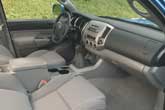
Page 8: Engines
The Tacoma offers two new engines for 2005, a 164-hp, 2.7-liter inline four-cylinder, which powers most regular and extended cab models, and an impressive new 245-hp 4.0-liter V-6 is standard on X-Runner and Double Cab models and available as an option on PreRunner and four-wheel drive Access Cabs.The four-cylinder's 22 additional horsepower and improved fuel economy (22 city/28 highway) makes it a good compromise for those on a tight budget. The V-6 is the real stand-out performer, however, producing 55 more horsepower than the 3.4-liter engine it replaces. This V-6 engine also stacks up mighty well against the competition, cranking out more horsepower and very nearly as much torque as the Dodge Dakota's standard 4.7-liter V-8 while still managing to return EPA fuel mileage estimates as high as 18 city/22 highway, albeit on pricier premium fuel. To put that power to the ground, four-cylinder buyers can choose from a five-speed manual or a four-speed automatic transmission. Two new transmissions are offered with the V-6, including a six-speed manual and a five-speed automatic. The final drivetrain decision is a choice between rear-wheel or part-time four-wheel drive. Four-wheel drive versions feature a two-speed transfer case with low-range for serious off-road capability. These new powerplants have a dramatic impact on performance numbers. According to Toyota, the V-6 four-wheel drive Tacoma with anautomatic can sprint from 0-to-60 in a respectable 7.5 seconds. Towing capacity has also been increased by 30 percent-1,500 pounds-over the 2004 model. Properly equipped, a V-6 Tacoma can pull a 6,500-pound trailer.
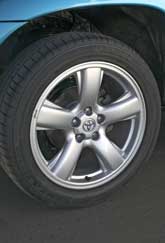
Page 9: Suspension
Even with more power, more towing capability and more cargo room, the 2005 Toyota Tacoma doesn't feel very truck-like. And it doesn't really matter what you're driving: two or four wheel drive, on or off-road, the ride and handling of the Tacoma is refined to the point where even a car person could appreciate it. And while there isn't anything radically different about the Tacoma's suspension design, we found that its tuning-the quasi-mystical process whereby engineers tweak spring rates and shock absorber settings to achieve a desired outcome-delivered a ride quality as good as many passenger cars. Particularly notable is the way the suspension set-up managed to keep its composure on stretches of rough pavement or rutted gravel roads. The Tacoma's handling characteristics were equally impressive. The optional Sport suspension package from Toyota Racing Development on our test truck allowed very little body roll in turns. This level of cornering stability in a pickup was startling; a performance we might not have believed had we not experienced it for ourselves.
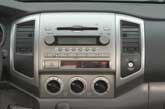
Page 10: Enzo & Tacoma
While the base model was good, the X-Runner raises on-pavement handling to the next level. With the suspension lowered one-inch and the same tires as those on the Ferrari Enzo supercar, this self-proclaimed "muscle truck" delivers lateral acceleration (cornering forces) of .9g's. To bring that abstract number into focus, that level of performance puts it in the same league as Nissan's 350Z sports car.Which should make those car people really take notice. As for the truck types out there, those looking for improved suspension performance in off-road situations will want to consider for the optional TRD Off-Road package. In addition to specially tuned and upgraded suspension components, both the Sport and Off-Road packages include a variety of appearance upgrades and convenience features. Adding to the driving experience is the Tacoma's excellent rack-and-pinion steering. The power-assisted system delivers good on-center feel and a nicely weighted action that makes it easy to hustle this truck along a twisty stretch of two-lane road. And just in case there's something on that twisty stretch of two-lane road, Toyota has equipped all models of the Tacoma with antilock brakes-10.83-inch discs up front (PreRunner and 4x4 models get 12.56-inch discs) and 10-inch drums out back.
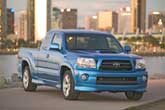
Page 11: Safety
Those standard antilock brakes are just the beginning. Product planners have also made Electronic Brake-force Distribution, a system that enhances control by distributing brake force optimally between all four wheels, standard on all Tacomas. Toyota's Brake Assist system, which senses emergency braking situations and brings maximum braking force to bear to reduce stopping distances, is also standard across the model line. Optional stability control adds a of safety by constantly comparing the truck's direction of travel with the driver's intended course and intervening to correct an impending skid before it happens. Traction control, which helps minimize wheelspin, is included with the stability control system. Dual-stage front airbags are standard on all Tacomas. Models with front bucket seats also get an occupant classification system which automatically turns off the front passenger airbag if the seat is occupied by a child or small stature adult that may be injured by the force of its deployment. A key-activated airbag on/off switch is also standard on Regular and Access Cab models. Torso-protecting side-impact and head-protecting side-curtain airbags-which have been shown to significantly reduce fatalities in broadside collisions-are offered as an option on Tacoma Double Cabs. Two slick new features available for the first time on Tacoma aim to take much of the drama out of climbing and descending steep hills. Aptly named Hill-start Assist Control, which uses automatic applications of the brakes to keep the vehicle from rolling backwards on uphill starts, is included on models equipped with an automatic transmission and the optional stability control system. Downhill Assist Control, which is standard on four-wheel drive models, does pretty much what the name implies -- limiting downhill speed in forward or reverse to under six miles-per-hour while automatically braking individual wheels as needed to help improve stability on steep downhill sections.
